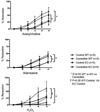Kv1.3 channels facilitate the connection between metabolism and blood flow in the heart
- PMID: 28504408
- PMCID: PMC5433265
- DOI: 10.1111/micc.12334
Kv1.3 channels facilitate the connection between metabolism and blood flow in the heart
Abstract
The connection between metabolism and flow in the heart, metabolic dilation, is essential for cardiac function. We recently found redox-sensitive Kv1.5 channels play a role in coronary metabolic dilation; however, more than one ion channel likely plays a role in this process as animals null for these channels still showed limited coronary metabolic dilation. Accordingly, we examined the role of another Kv1 family channel, the energetically linked Kv1.3 channel, in coronary metabolic dilation. We measured myocardial blood flow (contrast echocardiography) during norepinephrine-induced increases in cardiac work (heart rate x mean arterial pressure) in WT, WT mice given correolide (preferential Kv1.3 antagonist), and Kv1.3-null mice (Kv1.3-/- ). We also measured relaxation of isolated small arteries mounted in a myograph. During increased cardiac work, myocardial blood flow was attenuated in Kv1.3-/- and in correolide-treated mice. In isolated vessels from Kv1.3-/- mice, relaxation to H2 O2 was impaired (vs WT), but responses to adenosine and acetylcholine were equivalent to WT. Correolide reduced dilation to adenosine and acetylcholine in WT and Kv1.3-/- , but had no effect on H2 O2 -dependent dilation in vessels from Kv1.3-/- mice. We conclude that Kv1.3 channels participate in the connection between myocardial blood flow and cardiac metabolism.
Keywords: Kv 1.3 channels; contrast echocardiography; coronary blood flow; coronary microcirculation.
© 2016 John Wiley & Sons Ltd.
Figures




References
-
- Deussen A, Ohanyan V, Jannasch A, Yin L, Chilian W. Mechanisms of metabolic coronary flow regulation. J Mol Cell Cardiol. 2012;52:794–801. - PubMed
-
- Grover RF. Mechanisms augmenting coronary arterial oxygen extraction. Advances in cardiology. 1973;9:89–98. - PubMed
-
- Wolff CB. Normal cardiac output, oxygen delivery and oxygen extraction. Advances in experimental medicine and biology. 2007;599:169–182. - PubMed
-
- Tennant R, Wiggers CJ. THE EFFECT OF CORONARY OCCLUSION ON MYOCARDIAL CONTRACTION. 1935
-
- Berne RM, Rubio R, Dobson JG, Jr, Curnish RR. Adenosine and adenine nucleotides as possible mediators of cardiac and skeletal muscle blood flow regulation. Circ Res. 1971;28(Suppl 1):115+. - PubMed
Publication types
MeSH terms
Substances
Grants and funding
LinkOut - more resources
Full Text Sources
Other Literature Sources

